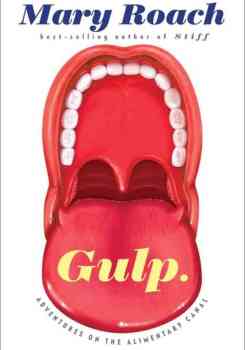The Story of Saliva
Why do newborns drool excessively? How many pints of saliva does a person generate daily? (Hint, it’s more than one.) And more spit mysteries excerpted from “Gulp: Adventures Down the Alimentary Canal.”
The following is an excerpt fromfrom Gulp. Adventures on the Alimentary Canal, by Mary Roach.
Humans secrete two kinds of saliva, stimulated and unstimulated, no more alike than most siblings. The prettier child is stimulated saliva. It comes from the parotid glands, between cheek and ear. When a plate of Erika Silletti’s spaghetti carbonara makes your mouth water, that’s stimulated saliva. It makes up 70 to 90 percent of the two to three pints of saliva each of us generates daily.
We’re going to gather some now. Silletti pulls on a pair of blue latex gloves that so pleasingly complement the gray of her sweater that they look like part of the ensemble. She picks up two stoppered plastic vials. Inside each is a second, smaller vial, which contains a tightly compressed, cylindrical cotton wad. This is the Salivette saliva collection system. Silletti uncaps a Sharpie and marks an M, for Mary, on one, and an E on the other.
The Salivette instructions are printed in six languages. Erika Silletti, born in Italy, fluent in English, living in the Netherlands, can read three. “Kauw dan 1 minuut lichtjes op de wattenrol.” “Masticate delicatamente il tampone per un minuto.” “Gently chew the tampon for one minute.” This is the simplest way to collect stimulated saliva without also collecting the food that stimulated it: you chew the collection device. This is “mechanical stimulation” (as opposed to gustatory or olfactory stimulation, which we’ll come to). Il tampone will wick our flow, and then Silletti will place each back in its vial and put them in a centrifuge. The liquid will be spun from the cotton and flow down through an opening at the bottom of the inner vial, ending up in the outer vial.

The Salivette makes an unmistakable point: your parotid glands don’t care what you chew. There is nothing remotely foodlike about superabsorbent cotton, yet the parotids gamely set to work. They are your faithful servants. Whatever you decide to eat, boss, I will help you get it down.
Allowing you to eat is the most obvious but far from the only favor granted by saliva. Silletti removes a bottle of wine vinegar from a tote bag. With a dropper, she squirts some on my tongue. “Do you feel it? Saliva is coming in the mouth to dilute the acid.” It’s as though I’d taken a sip of tepid water. “The communication between the brain and mouth,” says Silletti with infectious wonder. “It’s so fast!”
Vinegar, cola, citrus juice, wine, all are in the acid range of the pH scale: from around pH 2 to 3. Anything under pH 4 will dissolve calcium phosphate, a key component of tooth enamel. The process is called demineralization. Take a drink of anything acid, and if you are paying attention, you will notice a sudden warm slosh: parotid saliva arriving like the cavalry to bring the pH back up to the safe zone. Earlier, Silletti paged through a Dutch-language textbook on saliva (speeksel) to show me close-up photographs of teeth belonging to dry-mouthed people—those with Sjögren’s syndrome or whose salivary glands have been damaged by radiation treatments. “It’s really shocking,” she said, and it was: gaping brown lesions all along the gum line. “Their teeth are so soft that they cannot even eat properly.”
Sugar contributes to tooth decay only indirectly. Like humans, bacteria are fond of it. “Bacteria get all crazy—party, party—they metabolize the sugar, break it down, and they release their metabolites, and these are acid” (though not as acid as cola or wine). In other words, sugar itself doesn’t cause cavities; it’s the acidic metabolites of the bacteria that feed on the sugar. As with acidic foods, saliva dilutes the acid and brings the mouth back to a neutral pH.
You may be wondering, though probably not, why newborns—who have no teeth to protect—produce excessive volumes of drool. Silletti has answers. One is simple mechanics. “They lack teeth to physically keep it in there.” Your lower incisors are a seawall holding back the salivary tide. The other reason is the newborn’s high-fat, 100 percent whole-milk diet. Baby saliva—so cute!—contains extra lipase, an enzyme that breaks down fats. (Adults have lipase mainly in their intestines.) More saliva means more lipase. As babies move on to a more varied diet, the salivary lipase tapers off.
Excerpted from Gulp. Adventures on the Alimentary Canal, by Mary Roach. Copyright © 2013 by Mary Roach. Used with the permission of the publisher, W.W. Norton & Company, Inc.
Mary Roach is the author of Stiff: The Curious Lives of Human Cadavers, and many other books. Her writing has appeared in Outside, Wired, National Geographic, and The New York Times Magazine, among others. She lives in Oakland, California.